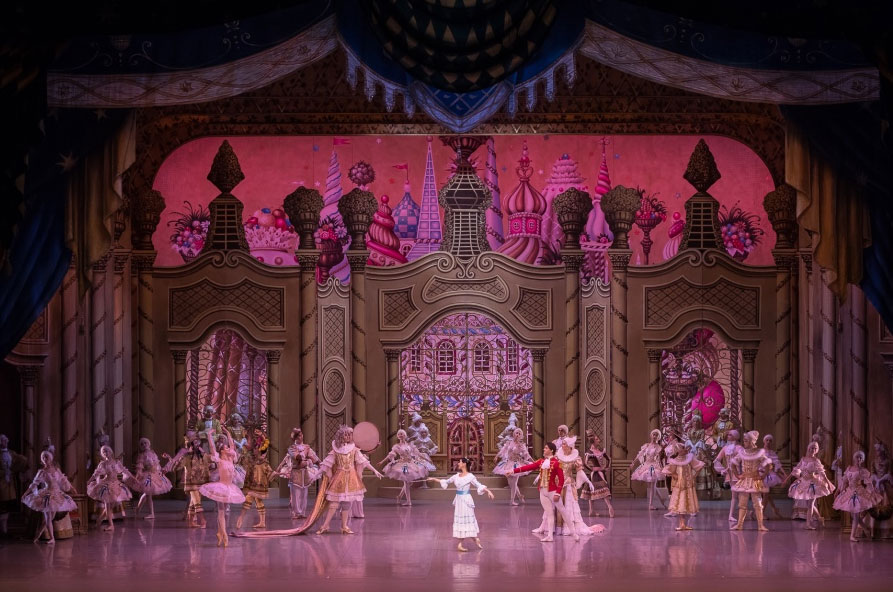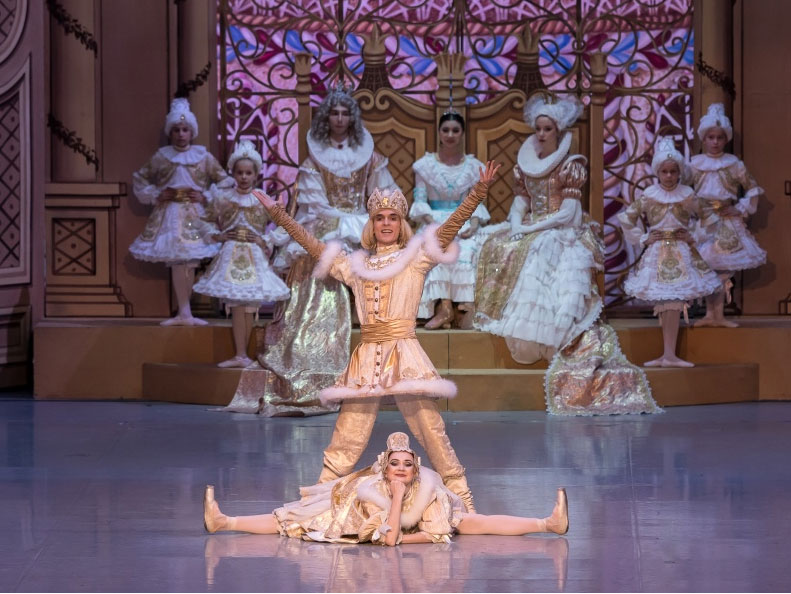 Any modern day choreographer who attempts to reset a classical ballet using his own steps is to be lauded for the task is daunting in the face of masters such as Petipa (“Swan Lake”) or, in the case of Russia’s most widely known version of “The Nutcracker”, its original choreographer, Vasily Vainonen.
Any modern day choreographer who attempts to reset a classical ballet using his own steps is to be lauded for the task is daunting in the face of masters such as Petipa (“Swan Lake”) or, in the case of Russia’s most widely known version of “The Nutcracker”, its original choreographer, Vasily Vainonen.
 Parts of this “Nutcracker” work better than others. Some of the highlights include the Prologue and Epilogue where “Drosselmeyer”/Hoffman (performed expertly by the mysterious Valeriy Ignatov) sits at his desk writing the tale that we then observe in dance form. These scenes set the tone for what we witness onstage. Portions of the ensemble snow scene verge on mastery: it’s no small feat to choreograph to Tchaikovsky for the volume of dancers on stage and the duration of this section of the score. Varied formations and step sequences, all retained within the classical lexicon, kept it engaging. The waltz of the flowers includes an eye-catching quartet of four courtiers (hinting both at one of the the genius sections in “Raymonda” and at the cavaliers from “The Sleeping Beauty”) here dressed in the same period costumes. While the Russian trepak (here a duet) dance drew the most applause, in part for its infectious music and gorgeous gold-and-white costumes, one imagined that more dramatic steps might have been included. There is no “Dresden trio” as in the Vainonen version, and while a King and Queen both escort Masha (“Clara” in Western versions) to the throne to watch the Sweets perform, the Sugar Plum fairy nonetheless dances the Grand Pas de Deux with the Prince. This mixture works however, and these slight shifts bear little significance for the younger members of the audience who judging by the silence, remained enraptured by both choreography and score until the final curtain.
Parts of this “Nutcracker” work better than others. Some of the highlights include the Prologue and Epilogue where “Drosselmeyer”/Hoffman (performed expertly by the mysterious Valeriy Ignatov) sits at his desk writing the tale that we then observe in dance form. These scenes set the tone for what we witness onstage. Portions of the ensemble snow scene verge on mastery: it’s no small feat to choreograph to Tchaikovsky for the volume of dancers on stage and the duration of this section of the score. Varied formations and step sequences, all retained within the classical lexicon, kept it engaging. The waltz of the flowers includes an eye-catching quartet of four courtiers (hinting both at one of the the genius sections in “Raymonda” and at the cavaliers from “The Sleeping Beauty”) here dressed in the same period costumes. While the Russian trepak (here a duet) dance drew the most applause, in part for its infectious music and gorgeous gold-and-white costumes, one imagined that more dramatic steps might have been included. There is no “Dresden trio” as in the Vainonen version, and while a King and Queen both escort Masha (“Clara” in Western versions) to the throne to watch the Sweets perform, the Sugar Plum fairy nonetheless dances the Grand Pas de Deux with the Prince. This mixture works however, and these slight shifts bear little significance for the younger members of the audience who judging by the silence, remained enraptured by both choreography and score until the final curtain.
 For this performance, Viktor Mulygin danced the Nutcracker Prince. A compact dancer with stable jumps, he provided reliable support to SugarPlum Fairy Ksenia Abdulkarimova, whose tight lines and gracious stage manner emitted the essence of the fairy kingdom.
For this performance, Viktor Mulygin danced the Nutcracker Prince. A compact dancer with stable jumps, he provided reliable support to SugarPlum Fairy Ksenia Abdulkarimova, whose tight lines and gracious stage manner emitted the essence of the fairy kingdom.